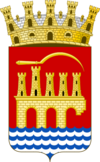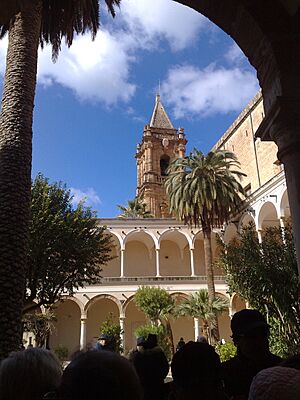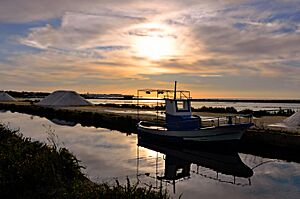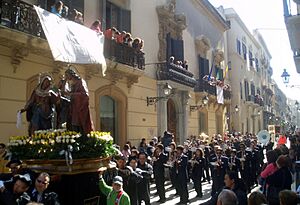Trapani facts for kids
Quick facts for kids
Trapani
|
|||
|---|---|---|---|
| Comune di Trapani | |||

Trapani seen from Erice. The islands of Favignana (left) and Levanzo (right) can be seen in the background
|
|||
|
|||
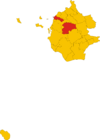
The comune of Trapani within the province of Trapani
|
|||
| Country | Italy | ||
| Region | Sicily | ||
| Province | Trapani (TP) | ||
| Frazioni | Marausa, Xitta, Palma, Fontanasalsa, Guarrato, Fulgatore, Salinagrande, Locogrande, Rilievo, Borgo Fazio, Ummari | ||
| Area | |||
| • Total | 271 km2 (105 sq mi) | ||
| Elevation | 3 m (10 ft) | ||
| Population
(March 31, 2020)
|
|||
| • Total | 67,531 | ||
| • Density | 249.2/km2 (645.4/sq mi) | ||
| Demonym(s) | Trapanese | ||
| Time zone | UTC+1 (CET) | ||
| • Summer (DST) | UTC+2 (CEST) | ||
| Postal code |
91100
|
||
| Dialing code | 0923 | ||
| Patron saint | St. Albert | ||
| Saint day | August 7 | ||
Trapani is a city and a local government area (called a comune) located on the west coast of Sicily, Italy. It is the main city of the Province of Trapani. The city was founded by the Elymians, an ancient people. Today, Trapani is an important fishing port. It is also the main way to reach the nearby Egadi Islands.
Contents
History of Trapani
Trapani was first called Drépanon. This name comes from a Greek word meaning "sickle". This is because its harbor has a curving shape, like a sickle. The city was built by the Elymians. It served as a port for the nearby city of Eryx, which is now called Erice. Erice sits on a mountain overlooking Trapani.
Carthage took control of Trapani in 260 BC. They used it as an important naval base. However, Rome gained control in 241 BC. This happened after the Battle of the Aegates Islands during the First Punic War.
There are two old stories about how Trapani might have started. One story says Trapani was formed from a sickle. This sickle fell from the hands of the goddess Demeter. She was looking for her daughter Persephone, who had been taken by Hades. The second story tells of Kronos. He used a sickle to defeat his father Ouranos, the god of the sky. When the sickle fell into the sea, it created the city. In ancient times, the god Saturn (also known as Baal Hammon) was the protector of Trapani. Today, you can see a statue of Saturn in a main square in the city.
After Roman rule, Trapani was taken over by different groups. These included the Vandals, Ostrogoths, and Byzantines. From 827 AD, the Arabs ruled the city. In 1077, the Normans led by Roger I took Trapani. The city grew a lot under their rule. It also played a big part in the Crusades. It was one of the most important ports in the Mediterranean Sea. In the early 1400s, some Maltese people lived in Trapani.
In the 1600s, the city faced problems like revolts, diseases, and hunger. But in the 1700s, its population grew from 16,000 to 30,000 people. Trade was important locally. Its military position in the Kingdom of Naples was also well-known.
Trapani was badly damaged during World War II. It was bombed heavily by the Allies. Since the war, the city has grown a lot. It now stretches almost to the base of Monte San Giuliano. In recent years, more tourists have visited Trapani. This is because it is close to popular places like Erice, Segesta, and the Egadi Islands.
Geography of Trapani
The city of Trapani is made of two separate parts. These parts are divided by the town of Paceco. The northern part has most of the city and some countryside. The larger southern part includes the Marausa area. It also has half of the Trapani-Birgi Airport and a large rural area. Some parts of the urban area, like Casa Santa, are not in Trapani. They are part of the town of Erice. The city of Trapani has about 70,000 people. But the whole urban area, including parts in Erice, has over 90,000 residents.
Economy
Trapani's economy still relies a lot on the sea. Fishing and canning are the main local businesses. Coral is also an important product that is sent to other places. Other exports include salt, marble, and marsala wine. Near the coast, you can see many saltworks. These are made by evaporating seawater. They are located along the road between Trapani and Marsala.
The city is also a key ferry port. You can take ferries from Trapani to the Egadi Islands, Pantelleria, Sardinia, France, and Tunisia. Trapani also has its own airport, the Trapani-Birgi Airport.
Fishing
Trapani is one of the traditional places for mattanza tuna fishing. This old method is now forbidden. However, the fishing port is still very busy. It has 142 small and medium fishing boats.
The old fish market was updated in 1998. It is now used for cultural events. A new, larger, and more modern fish market is located near the port. This new market is the only one in the Province. It has been improved with European money. This makes it a leading market in Italy for selling fish and tracking where products come from.
Coral Processing
Between the 1400s and 1500s, Trapani fishermen started catching coral. Coral craftsmen then began to process it. They became very skilled and known throughout the Mediterranean. They received many important orders from all over Europe. This allowed them to create richer and more detailed works. Today, coral fishing has almost stopped. Only a few craftsmen still work with coral.
Saltworks
The windmills and saltworks show the area's industrial past. The saltworks are located in the Natural Reserve of Saline di Trapani and Paceco. The WWF manages this reserve. It has amazing plants and animals. Because the reserve protects the area, salt production has increased. This has also helped many types of migratory birds return and reproduce. These birds include the pink flamingo.
Culture
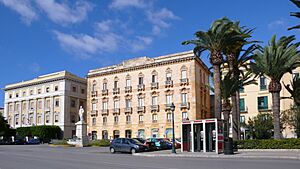
The old part of Trapani dates back to the Middle Ages and early modern times. There are no remains of the very ancient city. Many of the city's old buildings are built in the Baroque style.
- The Church of Sant'Agostino was built in the 1300s.
- The Church of Santa Maria di Gesù was built between the 1400s and 1500s.
- The Basilica-Sanctuary of Maria Santissima Annunziata is also called "Madonna di Trapani." It was first built in 1315–1332 and rebuilt in 1760. It holds the Museo regionale Agostino Pepoli and a marble statue of the Madonna of Trapani. This statue might have been made by Nino Pisano.
- Fontana di Tritone is a fountain of Triton.
- The Baroque Palazzo della Giudecca is also known as Casa Ciambra.
- The cathedral was built in 1421. It was restored in the 1700s by Giovanni Biagio Amico. It has a painting called "Annunciation" that is thought to be by Anthony van Dyck.
- The Church of Maria SS. dell'Intria is an example of Sicilian Baroque style.
- The Church of Badia Nuova is a small Baroque church.
- Castello di Terra is a ruined castle from the 1100s. Today, it is a police office.
- Ligny Tower is a watchtower from the 1600s. It now holds a prehistory museum.
- The Regional Museum Agostino Pepoli is in a Carmelite convent from the 1300s. It is next to the Basilica-Sanctuary of Maria Santissima Annunziata. It is one of Sicily's most important museums. It has decorative arts, sculptures (including works by the Gagini family), nativity scenes, and coral jewelry. It also has an art gallery with paintings by Titian and Giacomo Balla.
- The Museum of Prehistory is in the Torre di Ligny. This tower is at the westernmost point of the city. It displays important ancient evidence of human life in the area. It also has items found in the sea of Trapani, like artifacts, amphorae, anchors, and a Punic helmet.
- The Museum of Contemporary Art San Rocco is in Palazzo San Rocco, in the old city center.
- DiArt is a collection of religious art. It is housed in the episcopal seminary of Raganzìli in Casa Santa.
- The Diocesan Museum is in the Church of Sant'Agostino.
- The Optical Illusions Museum.
- Specus Corallii was designed by architect Antonino Cardillo.
Folklore
Trapani is famous for its Holy Week activities and traditions around Easter. The main event is the Processione dei Misteri di Trapani. People often just call it the Misteri di Trapani. This procession happens between Good Friday and Holy Saturday. It is a day-long parade organized by the city's guilds. It features twenty floats with sculptures made of wood, canvas, and glue. Most of these sculptures are from the 1600s and 1700s. They show different scenes from the events of the Passion of Christ.
The Misteri are among the oldest religious events in Europe that have happened continuously. They have taken place every Good Friday since before Easter of 1612. The procession lasts for at least 16 hours, and sometimes even more than 24 hours. This makes it the longest religious festival in Sicily and Italy. The worship of the Madonna of Trapani is also very important to the city.
The city also gives its name to a type of pesto. It is called pesto alla trapanese. This pesto uses almonds instead of the traditional pine nuts found in Ligurian pesto.
Transport
Trapani-Birgi Airport is an airport used by both military and civilian planes. It is the third busiest airport on the island. Recently, more people have used the airport. This is thanks to low-cost airlines flying from many parts of Europe. These include London, Paris, Dublin, Brussels, Munich, Frankfurt, Eindhoven, Stockholm, Malta, and Bratislava.
Sport
From September 28 to October 9, 2005, Trapani hosted Acts 8 and 9 of the Louis Vuitton Cup. This sailing race included all the boats that took part in the 2007 America's Cup.
The city is also home to the local football team, Trapani Calcio. The team was started in 1905. They are called the Granata (the Maroons) because of their kit color. In 2010, Trapani Calcio joined the 2010–11 Lega Pro Seconda Divisione (which used to be Serie C2). This ended the club's 13-year break from professional football. Later, they played in Serie B in the 2013–14 season. They currently play in Serie B with coach Fabrizio Castori.
Climate
Trapani has a hot-summer Mediterranean climate. This means it has hot and dry summers. Its winters are moderately wet and mild. Summer low temperatures are cooler than in other parts of Sicily and Calabria. However, they stay quite warm for several months.
| Climate data for Trapani, Sicily, 2000-2020, extremes 1991-2020 | |||||||||||||
|---|---|---|---|---|---|---|---|---|---|---|---|---|---|
| Month | Jan | Feb | Mar | Apr | May | Jun | Jul | Aug | Sep | Oct | Nov | Dec | Year |
| Record high °C (°F) | 20.4 (68.7) |
23.6 (74.5) |
29.0 (84.2) |
33.4 (92.1) |
39.4 (102.9) |
41.8 (107.2) |
41.4 (106.5) |
44.0 (111.2) |
38.0 (100.4) |
33.3 (91.9) |
27.0 (80.6) |
22.6 (72.7) |
44.0 (111.2) |
| Mean daily maximum °C (°F) | 15.0 (59.0) |
15.3 (59.5) |
16.6 (61.9) |
19.0 (66.2) |
23.1 (73.6) |
26.7 (80.1) |
29.7 (85.5) |
30.1 (86.2) |
27.7 (81.9) |
23.7 (74.7) |
19.4 (66.9) |
16.2 (61.2) |
21.9 (71.4) |
| Daily mean °C (°F) | 11.6 (52.9) |
11.7 (53.1) |
12.6 (54.7) |
14.6 (58.3) |
18.2 (64.8) |
21.7 (71.1) |
24.6 (76.3) |
25.2 (77.4) |
23.1 (73.6) |
20.0 (68.0) |
15.7 (60.3) |
12.8 (55.0) |
17.7 (63.9) |
| Mean daily minimum °C (°F) | 8.1 (46.6) |
8.0 (46.4) |
8.6 (47.5) |
10.2 (50.4) |
13.2 (55.8) |
16.6 (61.9) |
19.4 (66.9) |
20.2 (68.4) |
18.4 (65.1) |
15.4 (59.7) |
12.0 (53.6) |
9.3 (48.7) |
13.3 (55.9) |
| Record low °C (°F) | 0.0 (32.0) |
−0.2 (31.6) |
0.2 (32.4) |
1.8 (35.2) |
6.0 (42.8) |
10.2 (50.4) |
13.2 (55.8) |
15.0 (59.0) |
11.8 (53.2) |
6.8 (44.2) |
2.4 (36.3) |
0.6 (33.1) |
−0.2 (31.6) |
| Average precipitation mm (inches) | 56.3 (2.22) |
45.8 (1.80) |
44.9 (1.77) |
36.9 (1.45) |
16.8 (0.66) |
4.7 (0.19) |
2.4 (0.09) |
8.7 (0.34) |
41.6 (1.64) |
60.8 (2.39) |
64.7 (2.55) |
65.0 (2.56) |
448.6 (17.66) |
| Average precipitation days (≥ 1 mm) | 8.7 | 8.1 | 7.1 | 5.6 | 2.5 | 1.0 | 0.4 | 1.1 | 3.4 | 6.6 | 7.2 | 9.8 | 61.5 |
| Average relative humidity (%) | 79.85 | 78.7 | 77.71 | 74.44 | 72.01 | 70.79 | 71.67 | 71.33 | 73.65 | 76 | 78.41 | 80.03 | 75.38 |
| Average dew point °C (°F) | 7.8 (46.0) |
7.3 (45.1) |
8.5 (47.3) |
9.9 (49.8) |
12.9 (55.2) |
16.1 (61.0) |
19.0 (66.2) |
19.8 (67.6) |
18.1 (64.6) |
15.6 (60.1) |
12.0 (53.6) |
9.3 (48.7) |
13.0 (55.4) |
| Mean monthly sunshine hours | 133.3 | 145.0 | 189.1 | 219.0 | 226.3 | 306.0 | 347.2 | 319.3 | 255.0 | 210.8 | 159.0 | 127.1 | 2,637.1 |
| Source 1: Servizio Meteorologico | |||||||||||||
| Source 2: NOAA(humidity and extremes 1991-2020, dew point 1981-2010)
German Meteorological Service |
|||||||||||||
International Connections
Trapani has "twin town" or "sister city" relationships with other cities around the world. This means they share cultural and economic ties.
 Constanța, Romania
Constanța, Romania Les Sables-d'Olonne, France
Les Sables-d'Olonne, France Roquefort-les-Pins, France
Roquefort-les-Pins, France Würselen, Germany
Würselen, Germany
Trapani as Ancient Ithaca
Samuel Butler, a novelist, visited Trapani. He believed that the city and its nearby islands were the inspiration for Odysseus's home of Ithaca. This is described in Homer's famous story, the Oddysey. He also thought it was the place called Scheria, where Odysseus met Nausicaa.
Gallery
-
Our Lady of Trapani, the patroness of the town. Crowned in 1734 with a papal decree Pope Clement XII
See also
 In Spanish: Trapani para niños
In Spanish: Trapani para niños



